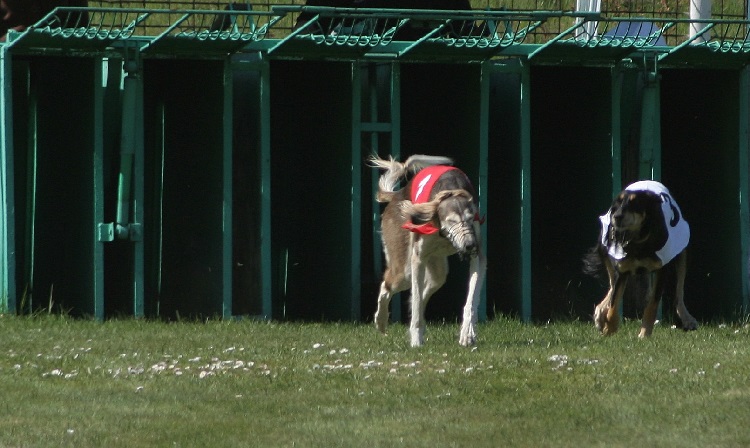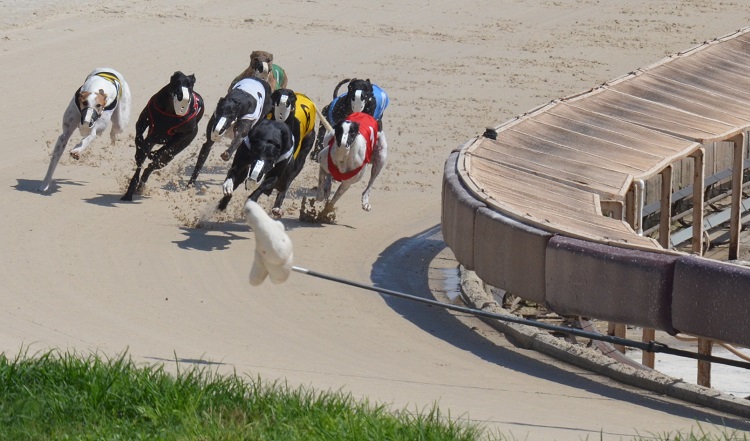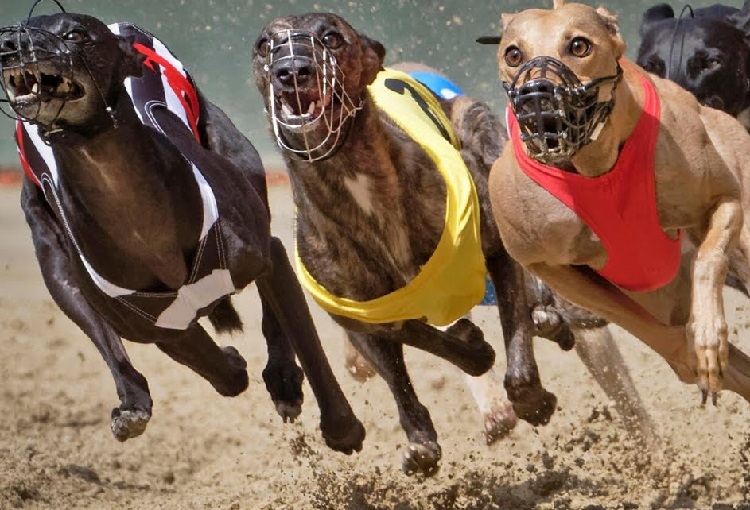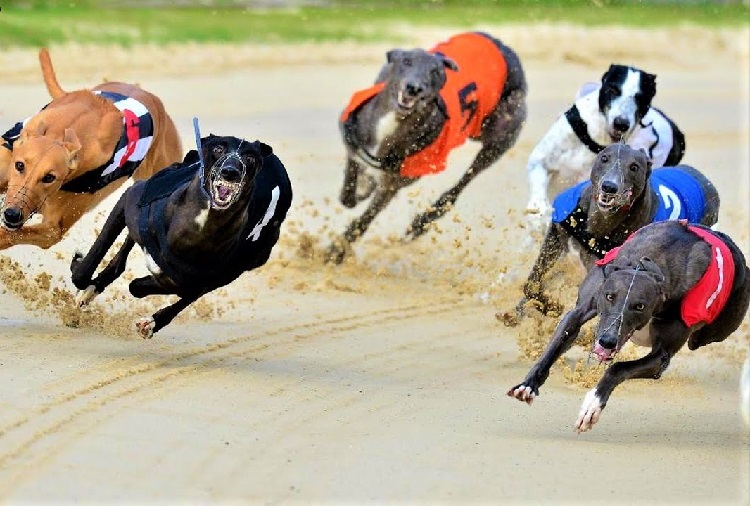Why Greyhound Dog Racing Is Cruel and Inhumane
Greyhound racing is inhumane on many levels. We’ll look at many facets of why dog racing is cruel. It is not just about serious injuries, animal cruelty, and how dogs die.

Greyhounds born into the dog racing industry don’t lead a life of luxury. Owners house them in compounds that resemble shacks. Typically, these kennels are cheaply built narrow barns with dog runs. Prison is a better word to describe these warehouses.
Owners stack these dogs in kennels or line them up in rows. Dogs only go outside for a short run to relieve themselves in a muddy, wet pen.
Most racing dogs spend 20 to 23 hours in barbaric track cages that measure 36 X 36 X 42 inches. This is barely enough room for Greyhounds to stand. Average Greyhounds stand to 30 inches at the shoulder.
Of course, it’s in the Greyhound owners’ best interest to feed their dogs. Otherwise, they’d end up with lethargic dogs. We’ll explain what food trainers provide these dogs. It’s not what you think nutritious dog food should be.
Greyhound Racing Is Full of Corruption and Gambling

No surprise, Greyhound racing is full of corruption. It’s also unethical, immoral, inhumane, and challenging to find an honest person. Though Greyhound racing falls under the Racing Commission umbrella, inside sources suggest that the dog racing industry is beyond unethical.
Few complaints receive valid attention. Dishonesty and corruption are staples of the dog racing and Greyhound breeding industry.
Sports betting is legal in many states. However, dog racing is officially illegal in 41 states. Also, many people know how to circumvent laws to their benefit. The health and life of a dog don’t fit into the equation. West Virginia still advertises Greyhound dog tracks.
Alabama, Arkansas, Texas, Iowa, and Texas support dog racing as a legal activity and have active dog race track facilities. Connecticut, Kansas, Oregon, and Wisconsin also allow dog racing, but no operational facilities exist. The Iowa Greyhound Park has closed to live racing and simulcasting.
Many states that don’t support active dog racing parks still allow their residents to make online sports bets in neighboring states. Through Greyhound advocacy pressure, many dog racing parks are closing. It’s become a dying industry
Greyhounds Suffer Catastrophic Injuries While Racing
Watching a dog run at 45 mph is a thrilling experience. Cheetahs, the fastest animal on earth, reach bursts of 65 to 75 mph to catch prey. They average 40 mph, making them slower than Greyhounds earning money. One would think that owners would treat these dogs like champions. Instead, Greyhounds routinely die.
Finally, many more get euthanized by electrocution. Getting accurate stats is difficult because few race dog owners make official reports. However, in an eight-year span, over 14,000 Greyhounds sustained injuries.
The HSUS suggests between 2008 and 2018, 15,273 race dogs suffered routinely documented injuries. The most common injury is broken legs.
In West Virginia, at two separate tracks, in the same ten-year span, 8159 dog injuries occurred. At least 398 dogs died in West Virginia or were euthanized.
In Arkansas, 1148 suffered injuries within the same period, and 35 dogs died. In Iowa, 417 Greyhounds got hurt, and 29 died.
Since most countries like Ireland, the USA, Australia, and Mexico don’t have to report, these numbers are low estimates. In that same eight-year period, over 1000 race dogs died from injuries or were euthanized because of their injuries.
Most Greyhounds have short racing careers. They average 18 months to 5 years on the circuit before they’re retired. Many lose their lives to injuries. Others are forced into retirement because they’re losing money on racetracks. Others are sent back to barracks for breeding.
Since dog owners can navigate so many loopholes, it’s difficult to gauge the extent of injuries and deaths from Greyhound racing.
Racing Commissions that should be monitoring and enforcing the few existing regulations willingly turn a blind eye. Though since 2008, 2200 offenders have faced disciplinary rulings. Perhaps this is for show.
A handful of fortunate canine souls get sent to rescue homes where they receive rest and pampering.

Every year, 8000 new litters enter the gaming world in the USA, Australia, and Ireland. This means that 48,000 puppies enter the system. Not all have the racing gene. Many of these puppies end up in destinations with no animal protection laws.
Greyhound racing owners only care about breeding the fastest dog. It goes without saying that many of these puppies end up dead. According to the ASPCA, over 80,000 Greyhounds pups are part of the racing industry and unscrupulous breeding methods.

Animal cruelty laws exist to protect pets, domesticated animals, and endangered species. That doesn’t change why people abuse animals. It’s inconceivable how low some individuals go to harm animals for profit, and dogs suffer.
Racing Greyhounds perform in a sport that cares about one thing–winning bets. Once the winning dog pays off, some owners send them to the worst animal facilities in underdeveloped countries where Greyhounds die.
Racing dog breeders abuse their dogs in many ways. Kenneling them in stacked wire pens and warehouse-style kennels is the accepted norm. Dogs suffer in these warehouse-style kennels without any human kindness while healing from Greyhound injuries.
Greyhounds only see daylight for a few outings each day to relieve themselves and when forced to perform on the track. All Greyhound racing owners must provide a standard-sized cage measuring 36 X 36 X 42 inches.
Greyhound warehouse-style kennels are probably on par for cruelty, with puppy mills for low standards. Perhaps they wrote the handbook on how to abuse dogs and make money while doing so.
The Disgusting Practices of the Greyhound Racing Industry | Prism of the Past
Concerns about the dogs’ welfare and declining betting revenue have led tracks across the country to close in recent decades.
It’s 8:30 on a Saturday night in August. A gibbous moon hangs low in the sky, its glow no competition for the neon sign proclaiming GREYHOUND RACING and DERBY LANE.
About 300 people are scattered in the grandstands here in St. Petersburg, Florida, that once held thousands, murmuring as loudspeakers play big band and rockabilly. They fall silent when Frederick Davis leads the parade of dogs.
“TNT Sherlock,” says the announcer, calling for the first of the eight sleek animals as Davis halts them in front of the stands. Each dog wears a number attached to a snug vest known as a blanket. “Tailspin,” the announcer calls, “Charlotte York …”
Next, Davis, 41, and the eight handlers he supervises put the dogs in the starting box. A mechanical rabbit named Hare-son Hare zooms past, squeaking and shooting blue sparks. The doors fly open, and the greyhounds burst onto the track in a blur of acceleration. Their paws toss sand in the air as they gallop around the oval for 30 seconds, hitting speeds of up to 45 miles an hour.
Derby Lane, which opened in 1925, was once hailed as the Churchill Downs of greyhound racing. Back when the dogs were running last year, you could still get a hint of the glamour and excitement of the track’s glory days in the 20th century. Back then, the stands would be packed with fans in suits and hats. Babe Ruth and entertainer Sophie Tucker were visitors. Joe DiMaggio once left Marilyn Monroe in an idling car while he ran inside to place his bets.
Derby Lane was America’s oldest continuously operating greyhound racetrack, but in December 2020 it headed for its final stretch. Two years earlier, Florida had more greyhound tracks than any other state—11 out of 17 nationwide. By the end of 2020, it was down to three, with about 2,000 dogs still racing. Now those tracks are closed too.
In 2018 Florida’s voters had the chance to approve a constitutional amendment—Amendment 13—to ban betting on greyhounds as of December 31, 2020. The racing industry bet on Floridians rejecting the amendment, but it passed by a wide margin, owing mostly to the growing national concern over the mistreatment of animals in the entertainment field, such as circuses.
Derby Lane’s last race was scheduled for December 27. Davis, a slender man with dreadlocks and a quick smile, was one of scores of employees whose future was uncertain. He’d been at the track for 14 years and considered it his ideal job.
“It’s a shame to have to shut down after 95 years,” said CEO Richard Winning, 64. His family has owned Derby Lane since it opened in 1925. With the Florida tracks closed, he warned, tracks elsewhere undoubtedly would follow. “In 20 years, will anyone even remember what greyhound racing was?”
This is the one thing on which he agrees with Carey Theil, whose Massachusetts-based advocacy group Grey2K USA spearheaded the drive for Amendment 13: Shut down Florida’s tracks, and there goes the industry.
The gray-bearded Winning is a born storyteller. He started at the track 45 years ago, collecting half-dollars from the turnstiles. He remembers when the regulars included rakish gamblers named “the Flicker” and “Champagne Tony,” the track restaurant served a 37-ounce prime rib, and a live band played between races.
Winning says greyhounds are the only dog breed in the Bible. That’s sort of true. The King James Version of Proverbs 30:29-31 cites them as “comely in going.” (Scholars say the original Hebrew refers to Afghan hounds or salukis.) The king’s translators knew about greyhounds because of a then popular sport called coursing, in which two greyhounds race to catch a rabbit. Queen Elizabeth I loved it—hence greyhound racing’s nickname, the “sport of queens.”
Dog racing as we know it today originated with an American inventor named Owen P. Smith, who was moved by the grim deaths of the rabbits to come up with an alternative. Smith’s idea was to replace the live rabbit with a mechanical one. In 1910 he secured a patent for what he called the Inanimate Hare Conveyor.
“Nobody in the history of any sport brought about a change comparable to that worked by the inventor of the device, and yet no inventor in sports history is so little known,” Sports Illustrated commented in 1973.
Smith and two partners also designed the first modern greyhound track, the Blue Star Amusement Company, which opened in 1919 outside Oakland, California. It failed, as did several others, because it didn’t allow betting. Gambling, while popular, was illegal.
The first successful track, the Miami Kennel Club, was one Smith and his partners opened in 1922 in a swampy Florida locale known as Humbuggus. It was so close to the Everglades that the owners employed a snake catcher to snag stray reptiles. The key to its success was the use of electric lights, according to Gwyneth Anne Thayer, author of Going to the Dogs, a book on greyhound racing and its place in popular culture. Lights meant that races could be run at night, when working people could attend. Amid Florida’s 1920s land boom, thousands of new residents sought evening entertainment. (The track later was converted to horse racing and renamed Hialeah Park.)
In 1925, on the other side of the state, Derby Lane opened under a cloud. The partners who built it ran out of money, so lumber magnate T.L. Weaver, Winning’s great-grandfather, took possession. He grew beans in the infield, track historian Louise Weaver says. Between races, he once had monkeys ride the dogs, their uniforms sewn to the greyhounds’ blankets so they couldn’t escape and the dogs couldn’t buck them off.
Although betting was illegal, the tracks “did something sneaky,” Winning said. “They sold shares in the dogs.” Winners would get a “dividend.” Losers would not. Other tracks ran “on the fix”—meaning they’d keep operating until raided and open again once the coast was clear.
In 1931, with the Great Depression bankrupting local governments, Florida legislators passed a bill to legalize and tax betting on the races. Governor Doyle Carlton, a devout Baptist, opposed it. Years later, he said gamblers offered him $100,000 to sign the bill. Instead, he vetoed it. State senators overrode his veto, making Florida the first state to legalize betting on dog races. Dog tracks then popped up in Tampa (1932), Orlando and Jacksonville (1935), Pensacola (1946), and Key West (1953).
Greyhound racing became part of Florida’s sun-and-fun . Mickey Mantle filmed a cigarette commercial at Derby Lane. Boxing champs and movie stars hung out at the tracks. The 1959 movie A Hole in the Head shows Frank Sinatra betting on Miami dog races.
Florida can be a sunny place full of shady people. The money involved in dog racing attracted plenty of them. Winning recalls Tampa mobster Santo Trafficante, Jr.’s minions placing bets at Derby Lane. Some mafiosi were more than customers. Charles “Lucky” Luciano and Meyer Lansky held an interest in South Florida dog tracks, says Scott Deitche, author of seven books on the Mafia.
Mob involvement sparked rumors about fixed races. Bettors said dogs were overfed to slow them down, or their toes cinched up with rubber bands to hamper their ability to run, or they were drugged to make them faster or slower.
Doping remained a problem into dog racing’s last years. In 2017 state officials revoked a Derby Lane trainer’s license because five of his greyhounds tested positive for cocaine, a stimulant. Months later, a trainer at another Florida track was suspended after a dozen dogs tested positive. In the two years that followed, state officials say, 11 more trainers’ dogs tested positive.
Doping has been just one of racing opponents’ concerns. Grey2K has spent nearly 20 years compiling reports on the welfare of racing greyhounds. It contends that even standard industry practices constitute mistreatment. It says dogs are forced to race under conditions that can cause serious injuries, such as broken legs and backs, fractured skulls and spines, and even electrocution by the lure. Another concern is what becomes of dogs that aren’t racing. In 1952 the Greyhound Racing Record said 30 percent of greyhounds bred for racing would compete, leaving open the fate of the other 70 percent. Dogs that do race stop being competitive around four years old. Grey2K has collected a raft of stories about greyhounds being euthanized or sold to laboratories. To address those concerns, in 1987 the industry formed the American Greyhound Council to set up adoption agencies and study what’s best for the dogs. Two of the worst scandals occurred in the 2000s, however.
In 2002 a former Pensacola track guard was arrested after authorities discovered that he’d killed 1,000 to 3,000 greyhounds and buried them on his property in Alabama. He said he’d been paid $10 each for shooting them. A prosecutor called the guard’s property a “Dachau for dogs,” according to a story in the New York Times. The guard died before he could be tried. In 2010 a trainer at a track in the Florida town of Ebro left dozens of dogs to die after the racing season ended. He pleaded guilty to cruelty, drawing a five-year sentence.
The scandals cut into greyhound racing’s popularity at a time when the public’s concern for animal welfare was rising. Meanwhile, new competing gambling operations—the Seminole and Miccosukee Tribes’ casinos and the Florida Lottery—lured customers from dog tracks.
The fans who remained skewed older. In 2001 Steven Soderbergh filmed a scene for Ocean’s Eleven at Derby Lane that featured George Clooney and Brad Pitt recruiting a man for their robbery scheme. Their target, Carl Reiner, then 79, fit in perfectly with the graying greyhound crowd.
In the track’s final days, its typical fan was Jim Wickert, 77, a retired golf course owner who since 2003 had shown up at Derby Lane twice a week in his tan Orvis fedora. He said he enjoyed the challenge of handicapping the dogs’ chances.
“I like trying to figure them out,” he said. “I don’t bet big, but it’s still exciting when you do figure things out and they run the way you think they should.”
Some people got into racing because they love greyhounds. Trainer and kennel owner John Farmer, a Klamath Tribe member from Oregon, said he fell in love with the breed when he was 11 and his mother let him watch races at Multnomah Greyhound Park. Now 55, he carries mementos of his winning dogs in an overflowing Tupperware container.
Greyhounds are affectionate animals, not particularly high-strung, said longtime veterinarian Donald Beck. In his time at Derby Lane, Beck said he was never bitten—but he had been scratched by excited dogs jumping on him.
When Winning recalls racing champions, one stands out: Keefer, the dog that won Derby Lane’s 1986 Distance Classic. That race drew 12,779 people—the largest crowd in track history. By 2020 Saturday races drew maybe a thousand.
The money brought in by live greyhound racing in its final decade dropped from $117 million a year to less than $40 million. At Derby Lane, it fell from $12 million to $4.3 million.
The industry tried to adapt, winning legislative approval in 1996 for poker rooms and for simulcasting, which lets bettors wager on races elsewhere. The poker rooms remained packed. After dog racing ended, simulcast races drew some fans. But they couldn’t save the dog tracks.
For a decade, Grey2K tried to persuade Florida legislators to reform greyhound racing, to no avail. Finally, the group appealed to the state’s Constitution Revision Commission, which meets every two decades, and persuaded commissioners to support a proposal to end racing.
The organization and its allies spent three million dollars advocating for Amendment 13, Theil says, mostly for TV ads showing mistreated racing dogs. Two groups opposing the amendment spent just $534,000 in response. One of the groups’ ads accused Grey2K of exaggerating the danger.
“The vast majority of the dogs are well trained, well treated, and well loved,” said Jack Cory, of the Florida Greyhound Association. He called Grey2K “pathological liars.”
Yet the industry drew little support beyond its fan base. Nearly 70 percent of the voters said yes to the amendment.
Besides the track employees losing jobs, the shutdown affected trainers and kennel owners. Farmer, for example, said he would relocate to West Virginia, one of the three remaining states (along with Iowa and Arkansas) that still have consistent racing seasons.
Grey2K USA is working to have racing banned in those states and in Australia, Ireland, Mexico, New Zealand, the United Kingdom, and Vietnam.
Greyhound adoption agencies set about finding homes for the Florida dogs that were still racing as of December 2020. One of those organizations was GST’s Sun State Greyhound Adoption, run by Sharon Dippel. She and her husband, Brian, have eight adopted dogs themselves. They go through a couple of 44-pound bags of dog food every 10 days or so.
Dippel said plenty of people lined up to adopt dogs. It helped that Florida’s tracks didn’t shut down simultaneously. Some closed shortly after the 2018 vote, others in early 2020 because of COVID-19.
As pets, greyhounds still like to run when they get outdoors, even without a mechanical device to chase, Dippel said. But when they get back indoors?